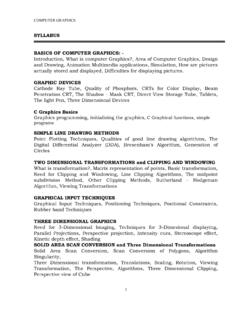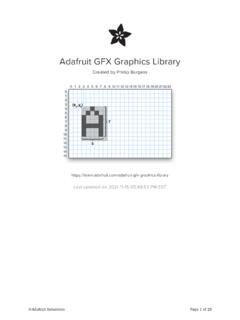Transcription of Lighting and Shading - Carnegie Mellon Computer Graphics
1 Lighting and Shading Properties of Light Light Sources Phong Illumination Model Normal Vectors [Angel, Ch. ]. Announcements Written assignment #1 due Thursday Handin at beginning of class Programming assignment #2 out Thursday 1. The Rendering Equation (Angel, Ch 13). Outline Lighting models (OpenGL oriented). Reflection models (Phong Shading ). Normals color 2. Common Types of Light Sources Ambient light: no identifiable source or direction Point source: given only by point Distant light: given only by direction Spotlight: from source in direction Cut-off angle defines a cone of light Attenuation function (brighter in center). Light source described by a luminance Each color is described separately I = [Ir Ig Ib]T (I for intensity). Sometimes calculate generically (applies to r, g, b). Ambient Light Intensity is the same at all points This light does not have a direction (or .. it is the same in all directions).
2 3. Point Source Given by a point p0. Light emitted from that point equally in all directions Intensity decreases with square of distance One Limitation of Point Sources Shading and shadows inaccurate Example: penumbra (partial soft shadow). 4. Distant Light Source Given by a vector v Intensity does not vary with distance (all distances are the same .. infinite!). Spotlight Most complex light source in OpenGL. Light still emanates from point Cut-off by cone determined by angle T. 5. Spotlight Attenuation Spotlight is brightest along ls Vector v with angle I from p to point on surface Intensity determined by cos I. Corresponds to projection of v onto Is Spotlight exponent e determines rate for e = 1. for e > 1. curve narrows For any of these light sources, it is easy to compute illumination arriving at a point ( , a vertex). 6. Now we can think about how the incoming light is reflected by a surface Surface Reflection When light hits an opaque surface some is absorbed, the rest is reflected (some can be transmitted too--but never mind for now).
3 The reflected light is what we see Reflection is not simple and varies with material the surface's micro structure define the details of reflection variations produce anything from bright specular reflection (mirrors) to dull matte finish (chalk). Incident Light Camera Reflected Light Surface 7. Phong Illumination Model Calculate color for arbitrary point on surface Basic inputs are material properties and l, n, v: l = vector to light source n = surface normal v = vector to viewer r = reflection of l at p (determined by l and n). Basic Calculation Calculate each primary color separately Start with global ambient light Add reflections from each light source Clamp to [0, 1]. Reflection decomposed into Ambient reflection Diffuse reflection Specular reflection Based on ambient, diffuse, and specular Lighting and material properties 8. Ambient Reflection Intensity of ambient light uniform at every point Ambient reflection coefficient ka, 0 w ka w 1.
4 May be different for every surface and r,g,b Determines reflected fraction of ambient light La = ambient component of light source Ambient intensity Ia = ka La Note: La is not a physically meaningful quantity Diffuse Reflection Diffuse reflector scatters light Assume equally all direction Called Lambertian surface Diffuse reflection coefficient kd, 0 w kd w 1. Angle of incoming light still critical 9. Lambert's Law Intensity depends on angle of incoming light Recall l = unit vector to light n = unit surface normal T = angle to normal cos T = l d n Id = kn (l d n) Ld With attenuation: q = distance to light source, Ld = diffuse component of light Specular Reflection Specular reflection coefficient ks, 0 w ks w 1. Shiny surfaces have high specular coefficient Used to model specular highlights Do not get mirror effect (need other techniques). specular reflection specular highlights 10. Shininess Coefficient Ls is specular component of light r is vector of perfect reflection of l about n v is vector to viewer I is angle between v and r Is = ks Ls cosD I.
5 D is shininess coefficient Compute cos I = r d v Requires |r| = |v| = 1. Multiply distance term Higher D is narrower Summary of Phong Model Light components for each color : Ambient (L_a), diffuse (L_d), specular (L_s). Material coefficients for each color : Ambient (k_a), diffuse (k_d), specular (k_s). Distance q for surface point from light source l = vector from light r = l reflected about n n = surface normal v = vector to viewer 11. Comparison of Phong model to the rendering equation Raytracing Example Martin Moeck, Siemens Lighting 12. Radiosity Example Restaurant Interior. Guillermo Leal, Evolucion Visual BRDF. Bidirectional Reflection Distribution Function Measure for materials Isotropic vs. anisotropic Mathematically complex 13. Accurate normal vectors are important for modeling surface reflection Normal Vectors Summarize Phong Surface normal n is critical Calculate l d n Calculate r and then r d v Must calculate and specify the normal vector Even in OpenGL!
6 Two examples: plane and sphere 14. Normals of a Plane, Method I. Method I: given by ax + by + cz + d = 0. Let p0 be a known point on the plane Let p be an arbitrary point on the plane Recall: u d v = 0 iff u orthogonal v n d (p p0) = nd p nd p0 = 0. We know that [a b c 0] Td p0 = -d (because p0. satisfies the plane equation). Consequently n0 must be [a b c 0]T. Normalize to n = n0/|n0|. Normals of a Plane, Method II. Method II: plane given by p0, p1, p2. Points must not be collinear Recall: u e v orthogonal to u and v n0 = (p1 p0) e (p2 p0). Order of cross product determines orientation Normalize to n = n0/|n0|. 15. Normals of Sphere Implicit Equation f(x, y, z) = x2 + y2 + z2 1 = 0. Vector form: f(p) = p d p 1 = 0. Normal given by gradient vector Normalize n0/|n0| = 2p/2 = p Angle of Reflection Perfect reflection: angle of incident equals angle of reflection Also: l, n, and r lie in the same plane Assume |l| = |n| = 1, guarantee |r| = 1.
7 Solution: D = -1 and E = 2 (l d n). Perhaps easier geometrically 16. Summary: Normal Vectors Critical for Phong model (diffuse and specular). Must calculate accurately (even in OpenGL). Pitfalls Not unit length How to set at surface boundary? color .. Why RGB? 17. Physics of Light and color It's all electromagnetic (EM) radiation Different colors correspond to different wavelengths O. Intensity of each wavelength specified by amplitude Frequency Q S O. long wavelength is low frequency short wavelength is high frequency We perceive EM. UDGLDWLRQ ZLWK LQ WKH . 400-700 nm range color : What's There vs. What We See Human eyes respond to visible light . tiny piece of spectrum between infra-red and ultraviolet color defined by emission spectrum of light source amplitude vs wavelength (or frequency) plot Amplitude Wavelength O. UV Visible IR. 18. The Eye The image is formed on the retina Retina contains two types of cells: rods and cones Cones measure color (red, green, blue).
8 Rods responsible for monochrome night-vision The Fovea Three types of cones: S,M,L. Corresponds to 3 visual pigments Roughly speaking: - S responds to blue - M responds to green - L responds to red Cones are most densely Note that these are not uniform packed within a region of the - more sensitive to green than red retina called the fovea Colorblindness - deficiency of one cone/pigment type 19. color Filters Rods and cones can be thought of as filters Cones detect red, green or blue parts of spectrum Rods detect average intensity across spectrum To get the output of a filter Multiply its response curve by the spectrum, integrate over all wavelengths A physical spectrum is a complex function of wavelength But what we see can be described by just 3 numbers the color filter outputs How can we encode a whole function with just 3 numbers? A: we can't! We can't distinguish certain colors--metamers G R. Amplitude B.
9 Wavelength color Models Okay, so our visual system is quite limited But maybe this is good news.. We can avoid computing and reproducing the full color spectrum since people only have 3 color channels TV would be much more complex if we perceived the full spectrum transmission would require much higher bandwidths display would require much more complex methods real-time color 3D Graphics is feasible any scheme for describing color requires only three values lots of different color spaces--related by 3x3 matrix transformations 20. color Spaces There are many ways to describe color Spectrum allows any radiation (visible or invisible) to be described usually unnecessary and impractical RGB. convenient for display (CRT uses red, green, and blue phosphors). not very intuitive HSV. an intuitive color space H is hue - what color is it? S is saturation or purity - how non- gray is it? V is value - how bright is it? H is cyclic therefore it is a non-linear transformation of RGB.
10 CIE XYZ. a linear transform of RGB used by color scientists HSV. From mathworks B G V. G. R. R. B. G H. R B S. 21. Additive vs. Subtractive color Working with light: additive primaries Red, green and blue components are added by the superposition property of electromagnetism Conceptually: start with black, primaries add light Working with pigments: subtractive primaries Typical inks (CMYK): cyan, magenta, yellow, black Conceptually: start with white, pigments filter out light The pigments remove parts of the spectrum dye color absorbs reflects cyan red blue and green magenta green blue and red yellow blue red and green black all none Inks interact in nonlinear ways--makes converting from monitor color to printer color a challenging problem Black ink (K) used to ensure a high quality black can be printed The Meaning of color . What's an image? Irradiance: each pixel measures the incident light at a point on the film Proportional to integral of scene radiance hitting that point What's color ?











